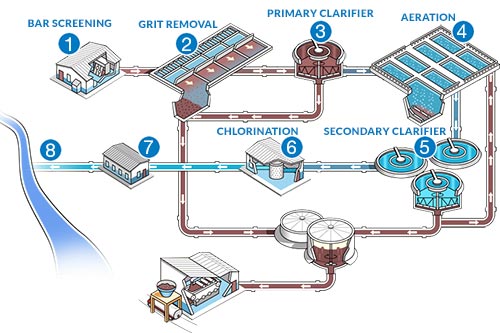All-in-One Wastewater Services for Home and Commercial Needs
All-in-One Wastewater Services for Home and Commercial Needs
Blog Article
Understanding Wastewater Therapy Processes and Their Environmental Influence
The intricacies of wastewater treatment processes play a pivotal function in mitigating ecological challenges linked with water contamination. Each phase, from preliminary to sophisticated therapies, is created to resolve particular pollutants, eventually guarding both public health and marine environments.
Introduction of Wastewater Therapy
How is wastewater changed right into a safe resource for the atmosphere? Wastewater therapy is a vital procedure designed to get rid of pollutants from made use of water, thus safeguarding public health and safeguarding ecosystems. This process begins with the collection of wastewater from household, industrial, and commercial resources, which is then directed to therapy centers.
At these facilities, numerous physical, chemical, and biological approaches are employed to treat the wastewater. Consequently, organic treatments, such as triggered sludge procedures, utilize microbes to break down natural matter.
The treated effluent can be safely released right into all-natural water bodies or reused for irrigation and commercial purposes, advertising resource preservation. Additionally, the treatment procedure generates biosolids, which can be repurposed as plant foods or soil changes, further improving sustainability.
Phases of Treatment Procedures
The wastewater treatment procedure commonly includes three main phases: initial, main, and additional therapy. Each phase offers an unique function in minimizing the toxin load and making certain the effluent meets ecological standards before discharge.

The primary treatment stage concentrates on the physical splitting up of suspended solids from the wastewater. Through sedimentation, larger particles resolve at the base of sedimentation storage tanks, developing sludge, while lighter products, such as oils and greases, float to the surface area and are skimmed. This process significantly lowers the organic and inorganic tons in the wastewater.
Additional therapy is a biological procedure aimed at further reducing the concentration of raw material. Various techniques, consisting of turned on sludge systems and dripping filters, make use of microorganisms to metabolize organic toxins. This stage is important for accomplishing the necessary biochemical oxygen demand (BODY) decrease, inevitably leading to cleaner effluent prepared for discharge or additional treatment. Each phase is important in guarding ecological and public health.

Advanced Therapy Technologies
Following the second treatment processes, advanced therapy innovations play an essential duty in additional improving the high quality of treated wastewater. These technologies are developed to eliminate residual pollutants that are not successfully gotten rid of during key and secondary treatments, making sure the effluent meets stringent regulative criteria.
Among the widely utilized sophisticated therapy methods are membrane purification, reverse osmosis, and advanced oxidation procedures. Membrane layer filtering, consisting of microfiltration and ultrafiltration, works in separating fine bits, pathogens, and colloids from the water (Wastewater). Reverse osmosis utilizes semi-permeable membranes to get rid of liquified solids, leading to high-quality water appropriate for numerous applications
Advanced oxidation processes (AOPs) employ strong oxidants to deteriorate natural pollutants, including pharmaceuticals and individual care products that are resistant to standard treatment. These approaches boost the biodegradability of complex substances, facilitating their removal.
One more click over here considerable modern technology is the click here for more info use of biological nutrient removal procedures, which specifically target nitrogen and phosphorus, avoiding eutrophication in getting water bodies. Overall, sophisticated therapy modern technologies are crucial for accomplishing greater degrees of purification, promoting water reuse, and guarding public wellness while attending to the challenges connected with wastewater management.
Environmental Benefits of Therapy
Numerous environmental advantages emerge from efficient wastewater therapy procedures that add to ecosystem health and sustainability. Mostly, these processes considerably minimize the release of harmful toxins into natural water bodies, which assists maintain aquatic environments. By getting rid of contaminants such as heavy metals, nutrients, and virus, treated wastewater minimizes the threat of waterborne illness and promotes biodiversity in marine environments.
Furthermore, wastewater treatment facilities typically utilize advanced innovations that make it possible for water recycling and reuse. This technique not just saves fresh water sources but additionally lowers the demand on all-natural water supplies. Enhanced nutrient removal from wastewater can also stop eutrophication, a process that leads to algal blossoms and subsequent oxygen exhaustion in water systems.
Furthermore, effective therapy procedures can reduce greenhouse gas discharges, especially methane and nitrous oxide, which are typically released during unattended wastewater disintegration. By recording and making use of biogas from anaerobic digesters, centers can convert waste into renewable resource, therefore adding to a decrease in nonrenewable fuel source dependency.
Challenges and Future Fads
While the environmental benefits of wastewater therapy are clear, a number of challenges linger that prevent optimum outcomes in this area. One significant problem is maturing facilities, which often causes ineffectiveness and enhanced operational prices - Wastewater. Many treatment plants were developed decades back, and their capabilities do not align with modern-day demands, which consist of stricter regulative requirements and greater volumes of wastewater due to urbanization

Looking in advance, there is an expanding focus on resource healing and round economic situation concepts within wastewater treatment. Developments such as anaerobic digestion, which can generate biogas, and advanced filtration innovations are gaining traction. These methods not just enhance treatment effectiveness however additionally advertise sustainability.
Ultimately, addressing these challenges requires cooperation among stakeholders, financial investment in technology, and a commitment to ongoing study. By accepting these trends, the wastewater treatment sector can develop to satisfy the demands of a changing environment and society.
Verdict
Finally, wastewater treatment processes play an important function in improving environmental high quality and public health. The multi-stage treatment framework, coupled with advanced innovations, successfully reduces air pollution and promotes lasting water management. By resolving recurring impurities and decreasing nutrition drainage, these procedures add to the preservation of aquatic environments and the reduction of greenhouse gas exhausts. Proceeded innovations and adaptations in therapy techniques will certainly be essential for conquering arising obstacles and making sure the sustainability of all-natural resources (Wastewater).
Report this page